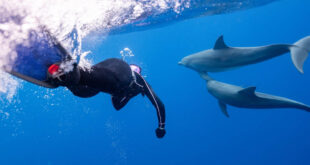Life really is bizarre. As we grow up, we come to realize how different the world is and how some things never make any sense. Maybe that’s why teachers tend to focus on topics which are fundamental and well-known facts. Beyond those boring basics, there’s so much more to explore and learn. Our planet is filled with weird anomalies and geographical facts that make us wonder why we haven’t heard of them until now! Here, we have collected some bizarre bits of knowledge that is sure to impress you.
1. You can be in 4 states at the same time.

The Four Corners Monument is a point where New Mexico, Arizona, Colorado, and Utah all meet. The rare geographical occurrence is the only one of its kind in the US. People have been traveling across the country to visit this quadripoint, and be in four states at the same time, from as early as 1908. Today, close to half a million people visit to have their photos taken with each of their limbs in a different U.S. state. (source)
2. The Dingo Fence in Australia is longer than the Chinese—Russian border.

The Dingo Fence was built in 1885, to keep Dingos and other wild dogs out of South-Eastern Australia, since they were harming sheep flocks. Also known as the Dog Fence, it stretches across two southeastern Australian states; Queensland and South Australia. Stretching 5,614 kms or 3,488 miles, it is one of the longest structures in the world and the world’s longest fence. Queensland shepherds and farmers were fed up with wild dingos who were harming their livelihood and so, erected the structure.
It was not always known as a dog fence. In fact, it was built to also keep rabbits out, in order to stop the spread of the rabbit plague across state borders. Later on, the government funded to heighten and expand the fence since rabbits were still hopping above or burrowing beneath it. Until 1980, the fence was 8,614 kms or 5,352 miles long, but was then shortened to 5,614 kilometers since dingos play a vital role in maintaining the balance of nature. (source)
3. The world’s largest desert is located in Antarctica.

Most people associate desert with heat and sand but the largest desert in the world is in fact the coldest and driest place on Earth. Scientifically, a desert is an area that receives a significantly small amount of rainfall. Most deserts are quite barren and the dry living conditions are too hostile to support plant and animal life. So, geographically, as well as scientifically, Antarctica is the largest desert in the world. It is the driest, windiest, and coldest continent on earth.
Due to extreme temperatures and a lack of water, there are no permanent residents in Antarctica but depending on the time of the year, there are around 1,000 to 5,000 temporary residents who conduct studies. The Antarctic Desert covers a total area about 5.5 million square miles , where as the Sahara Desert occupies a surface area of about 3.5 million square miles. (source)
4. Pheasant Island, located in the river Bidassoa, is owned by both Spain and France. Every six months the countries switch ownership of the island with each other.

Can two countries be friends and own a piece of land equally without starting a war? Yes they can, and the Pheasant Island, located in the river Bidassoa, is the proof of that. Every year, both countries hand over ownership of the island voluntarily with each other after claiming ownership for six months. The tradition has been going on for more than 350 years, without a single soul becoming victim.
In 1659, a peace agreement was signed – the Treaty of the Pyrenees – and the deal was sealed with a royal wedding, as the French King Louis XIV married the daughter of the Spanish King Philip IV. Since then, the island itself was to be shared between the two countries, with control rotating from one to the other every six months. From February 1 to July 31, it’s under Spanish rule – and for the following six months, it’s French. (source)
5. There are 42 buildings in New York City that have their own zip codes.

“The City That Never Sleeps” is packed with millions of people. It is by far the largest city in the United States, with an estimated 8.5 million people and another 4 million people visiting the island every day. There’s a lot of mail moving through the city and JFK International Airport handles millions of mail and packages every day. Getting all that mail to where it needs to go is a monumental task and ZIP codes makes it easier to get around.
Interestingly enough, there are 42 buildings in New York City with their own ZIP codes. ZIP codes are not provided to buildings depending on the size or population. For instance, the World Trade Center is the city’s tallest building, yet does not get its own ZIP code. Rather, ZIP codes correspond to delivery zones and routes, which can vary in different areas. Some of the buildings with their own ZIP codes include, One Penn Plaza, Kratter Building, Equitable Building and so on. (source)
6. In Canada, there’s an island in a lake on an island in a lake on an island.

Ken Jennings is an author, computer scientist, and trivia geek. He also holds the longest winning streak in the history on the game show Jeopardy!, a 74-game run in which he won $2,520,700. Eight years after gaining fame, he made a startling discovery. In 2012, he was scanning through Google Earth when found the world’s largest third order island, a nameless isle within Victoria Island. It was an island inside a lake, which is completely surrounded by another island, which is completely surrounded by another lake, which itself is located on Victoria Island, which is located in the Arctic Ocean. It is also quite possible that the location has been untouched by civilization until now. (source)
7. It’s a common misconception that Mount Everest is the world’s highest mountain. However, the tallest mountain in the world is actually located in the United States.

At 29,028 feet (or 8,848 meters), Mount Everest is considered the world’s highest mountain above sea level. However, the tallest mountain in the world is actually located in the United States. Hawaii’s Mauna Kea is over 32,000 feet (10,000 meters) tall when measured from the seafloor. When measuring mountain summits by their height above sea level, Mount Everest is the highest mountain in the world. Because Mauna Kea only reaches 13,796 feet (4,205 meters) above sea level—and over half of its base sits beneath sea level—it often doesn’t receive the same hype as the Everest. (source)
8. The stadium Estadio Milton Correa in Brazil is located in two different hemispheres; which means that every time there’s a football (soccer) match, the teams are playing against each other from different hemispheres.

Estádio Milton Corrêa, usually known as Zerão, is a stadium located in Brazil. Built in 1990, it hosts football (soccer) matches. The stadium gained popularity after it was discovered that the stadium is close to the equator. According to CNTraveler, “The stadium was built so that the midfield line follows the Equator exactly. In every soccer game there, each team isn’t just defending its own goal. One side is defending the Northern Hemisphere, and the other side the Southern Hemisphere, like a giant game of Risk. But the geopolitical overtones switch in the second half, of course, when the teams swap goals.” (source)
9. Point Nemo is the most challenging point to reach in the world.

At more than 1,000 miles from civilization in all directions, Point Nemo is unlike any other place in the world. Point Nemo is literally “the middle of nowhere”, and is so far away from civilization that the closest humans to that location at any given time are likely to be astronauts. Located at 48°52.6′S 123°23.6′W, it is surrounded by more than 1,000 miles of ocean in every direction. (source)
10. Glaciers store most of the Earth’s fresh water.

Believe it or not, even though we are surrounded by oceans, lakes, and rivers, around 70% of the freshwater on Earth is in the form of glaciers and ice caps. Around 10% of land area on Earth is covered with ice and this 10% is responsible for storing about 70% of the world’s fresh water. (source)




